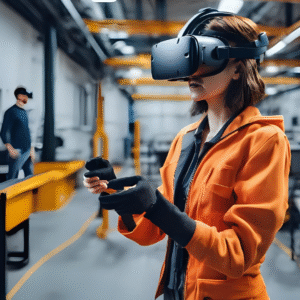Let’s not kid ourselves: most training sessions are boring. You sit through long presentations, skim manuals, or click through another “Next” button in some e-learning course you’ll forget tomorrow.
But in 2025, something’s shifting, and it’s real: VR training is showing up in places you wouldn’t expect. It’s not just flashy tech anymore. It’s turning into something practical.
So which industries are actually using virtual reality to train people? More importantly, why is it working?
Let’s dig into the real-world cases.

Healthcare: Practice Before the Pressure
In hospitals, you don’t get second chances. That’s why many medical schools and hospitals now include VR training to rehearse before stepping into the chaos of real emergencies.
Think about it:
Interns walking through surgeries without a single patient.
Paramedics rehearsing trauma response—again and again.
Nurses preparing for rare situations they might see once in five years.
The simulations aren’t perfect, but they’re close enough to build confidence. That alone is worth the investment.
Manufacturing: Learn the Dangerous Stuff Safely
If you’ve ever been near a factory floor, you know there’s no margin for error. One wrong move with a machine can mean serious injury—or worse.
VR solves that problem by letting workers learn equipment operation and emergency protocols before touching the real thing.
It also makes onboarding easier. No need to shut down a line or take senior staff off-task. Load up the headset, and new hires can learn on their own, at their pace, without risk.
Construction: Safer Sites, Smarter Planning
Construction sites are loud, complex, and constantly changing. You don’t get much room for “learning as you go.”
That’s why many firms are introducing VR simulations for crane operation, structural safety drills, and even fire evacuation plans. It helps:
Visualize high-risk areas
Train for equipment use without renting expensive hardware
Run drills without sending 30 people outside for 30 minutes
Less downtime, fewer mistakes, more retention.
Retail: Soft Skills, Hard Practice
Walmart’s already doing it. Others are catching on.
Retail employees don’t just need to stock shelves. They need to talk to people. Angry ones. Confused ones. Sometimes, irrational ones.
So how do you train someone for that?
You don’t just tell them to “stay calm.” You put them in a situation—via VR—where a virtual customer yells at them. Or gets emotional. Or makes an impossible demand.
Suddenly, they’re not reading theory. They’re learning how to handle real-life heat—safely.

Aviation: Simulators, But Smarter
Flight simulators have been around for decades. But now VR is giving that same power to technicians, cabin crews, and airport staff—not just pilots.
Technicians can run virtual repairs on plane engines. Cabin crews rehearse turbulence protocols. Ground teams drill fire evacuations and communication breakdowns.
It’s like rehearsal for the rare stuff—without needing a hangar, a jet, or a full crew.
Education and Skilled Trades: Real Learning, Zero Risk
Welding. Electrical work. Plumbing. These things aren’t exactly “theoretical.” You need hands-on practice—and VR is stepping in where classrooms fall short.
More training centers are using VR to teach:
Step-by-step repairs
Safety walkthroughs
Hands-on builds—without the tools
And students are responding. It’s immersive, engaging, and better than a textbook.
So Why Is VR Training Actually Working?
Here’s what makes it stick:
It’s memorable. People remember what they experience.
It’s low-risk. Messing up doesn’t cost money or safety.
It’s repeatable. You can redo a drill 10 times—try doing that in real life.
It’s efficient. Learn faster. Learn better. Simple.
And as headsets get cheaper and apps more user-friendly, small businesses are jumping in too—not just tech giants.
Wrap-Up: Where Do You Fit In?
If you run a company, lead a team, or even handle HR—ask yourself:
Where are mistakes hurting us most?
What do new hires struggle with the most?
What’s too expensive or dangerous to train live?
There’s probably a VR solution out there. And you don’t need to roll it out everywhere. Start with one use case. One problem. Test it.
You’ll see why industries aren’t just experimenting with VR training anymore. They’re building it into how they grow.
Want help finding the right tool? Reach out here. We’ll keep it simple. No pressure.
